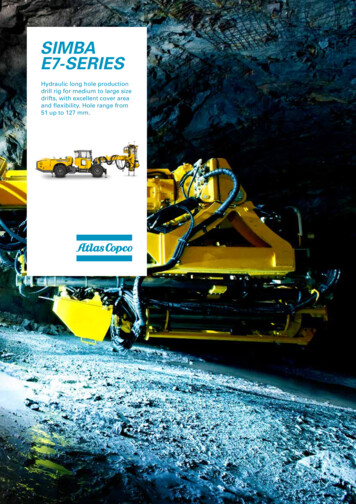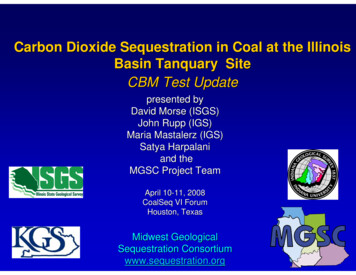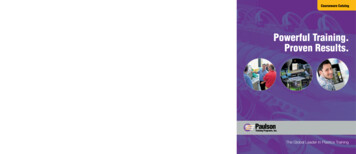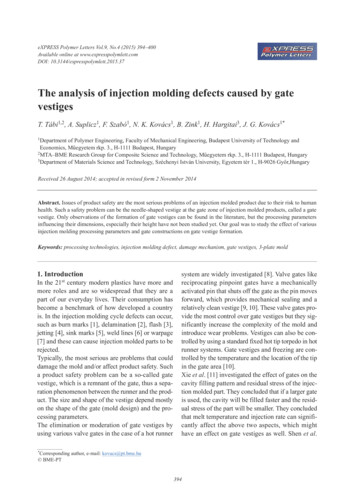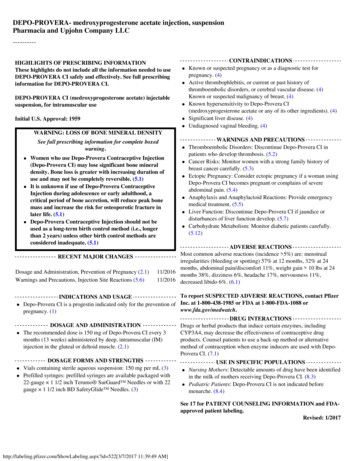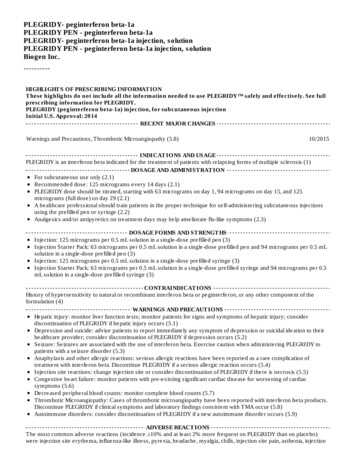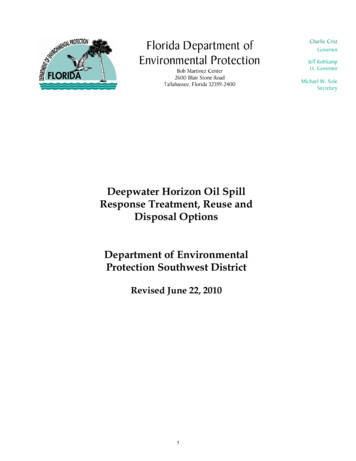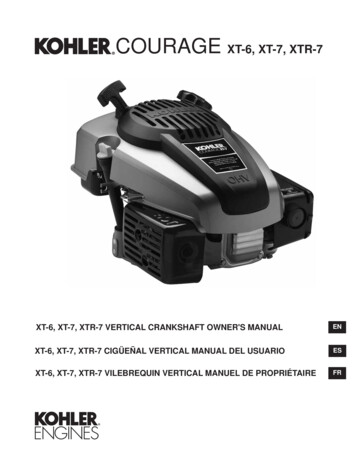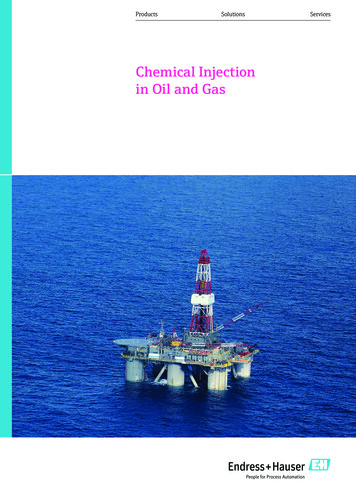
Transcription
ProductsSolutionsChemical Injectionin Oil and GasServices
White PaperChemical Injection in Oil and GasRegister21How to use level measurement and Inventory ManagementSystems for improving productivity32The role of chemical injections33Infrastructure protection: injecting chemicals to inhibit corrosion44Chemical injections to assure and condition flow by preventingbuild-ups55How to deal with risks66Inventory Management Systems for simplified, automated processes77How to select the right mass flowmeter 108What is important in selecting pressure and temperature transmitters9Summary 1110
White PaperChemical Injection in Oil and Gas1How to use level measurement and Inventory Management Systemsfor improving productivityIn all fields of the oil and gas industry, chemicals are injected into process lines and fluids. Take oilfieldservices (OFS), chemicals are used to film the side of the wellbore for improved stability. In pipelinesthey avoid build-up and keep the infrastructure healthy.But how may the operator optimize the chemical injection process and minimize Health, Safety andEnvironment (HSE) risks? The White Paper answers exactly this. It is about integrating the best fittinglevel measurement instrumentation and a suitable Inventory Management System. With this manyrisks are avoided and savings are possible like chemical recovery and just-in-time management.2The role of chemical injectionsIn the oil and gas industry we inject chemicals in orderto protect the infrastructureto optimize processesto assure flowand to improve productivity Chemicals are used in pipelines, tanks, machines and wellbores. It is crucial to avoid risks comingalong with the injections. Too little chemicals may lead to downtimes or process fluid cloggings, toomuch chemicals may damage the infrastructure and lead to empty supply tanks or complicate theregeneration process. It is also about the correct density of the product and the correct blending ofmultiple chemicals.3
White PaperChemical Injection in Oil and Gas3Infrastructure protection: injecting chemicals to inhibit corrosionCorrosion is a natural process, in which a metal gradually is destructed by a chemical or electrochemicalprocess while contacted with its environment. Typical sources of corrosion are pH, CO2, H2S, chlorides,oxygen and bacteria. Oil or gas are called “sour” when the concentration of hydrosulfides, H2S, is higherthan usually. Oxygen is extremely problematic on injection wells, EOR. Already very low concentrationscause high corrosion rates. In this case oxygen scavangers are used.Bacteria can grow inside pipes and tanks under anaerobic conditions, which generates highconcentrations of H2S. Pitting is a result of this and can get severe. Bacteria build-up mostly happens inlow velocity applications. Other contributing factores for corrosion are temperature, abrasion, pressure,velocity and the presence of solids.We know the following common types of corrosion:1. Local corrosion: pitting, crevice corrosion,filiform corrosion2. Galvanic corrosion3. General attack corrosion4. Flow-assisted corrosion, FAC5. Intergranular corrosion6. De-alloying7. Environmental cracking: stress, fatigue,H2-induced, liquid metal embrittlement8. Fretting corrosion9. High temperature corrosionFor controlling corrosion the following measures are important to regard: Be specific in selecting the right material. Metallurgic specialists define which metals are bestto use. Also coating and painting are relevant topics to choose well. Adjusting production to increase or decrease the velocity in a pipe. In case particles are present in the fluid, a decrease may be better for the lifetime ofinstruments and pipes Controlling the pH, reducing the chloride quantity, eliminating oxygen and bacteria andreducing the rate of metal oxidation with chemical injections. Effective and best composition of the chemicals to regulate the pressure in the pipeline orvessel where the fluid needs to go in.4
White PaperChemical Injection in Oil and Gas4Chemical injections to assure and condition flow by preventingbuild-upsIn order to prevent deposition typically inhibitors are injected. Depositions or build-ups in the oil andgas processes usually are asphaltenes, paraffins, scaling and hydrates. Of those asphaltenes are theheaviest molecules in crude oil. When they adhere, a pipeline can quickly plug. Paraffins precipitateout of a waxy crude oil. Scaling may be caused by the mixing of incompatible waters or by changes inflow like temperature, pressure or shear. Common oilfield scales are strontium sulfate, barium sulfate,calcium sulfate and calcium carbonate. To avoid those build-up inhibitors are injected. For preventingfreezing glycol is added.If we want to condition the flow we have to prevent emulsions: they cause enormous production delays in separators avoid frictions like with asphaltenes reduce viscosity as oil is typically a Newtonian fluid5
White PaperChemical Injection in Oil and Gas5How to deal with risksThere are various risks associated with chemical injections. Sometimes the injected chemicals do nothave the desired effect, sometimes the process of deposition or corrosion just continues under injection.In case too much pressure is used for the injection, the production may be damaged. Or when the tanklevel is not measured correctly and a platform runs short of media, production may need to stop. Thosescenarios cost the operator, the service company, the oil company and everyone else in the downstreama lot of money. Refineries may charge penalties when supplies decrease or stop.Imagine an operator being very busy running operations, while several colleagues push him tochange his activities: The maintenance manager wants to take one system out of line for a periodicmaintenance check. The quality manager is knocking on the door demanding the implementation ofnew safety-rules. The well manager is pushing him to use less dense chemicals to prevent damageto the well. The operations manager wants dense or more viscous materials to minimize the risk ofbuildup. The HSE forces him to mix enough bio-degradable chemicals in the fluid.All colleagues with different demands, all pushing for ultimately the same thing: to improve operations,make them safer and keep the infrastructure fit. Nevertheless, running six chemical injection systemsfor eight production wells and two EOR wells is quite a challenging organization – especially when theinventory needs to be monitored, the fluid quality has to be checked, the system performance mustmatch the well properties and so on and on . In this case it is good to automate the process andwith a future perspective allow to run operations remote.6
White PaperChemical Injection in Oil and Gas6Inventory Management Systems for simplified, automated processesFor managing inventories correctly Inventory Management Systems are of big help for the operator.They support to improve regeneration processes and assist in optimizing fluid orderings. As a resultthose activities lead to additional cost benefits and answer the demands of the different colleagues: theHSE manager, the quality manager, the operations manager, the well manager and the maintenancemanager.How does it work? Let us use an example to explain how all chemical injections may be organized for asingle platform or a group of platforms.On a platform usually there are several injection skids for EOR, the oil and gas production and for thepipeline infrastructure.Choosing the right level measurement needs to consider a solution for Inventory ManagementSupplyCare SCE30BPOWERMODEMNETWORKWEB PLCMICRO SDSIMRESETANTENNAFXA42Fieldgate FXA427
White PaperChemical Injection in Oil and GasEach skid has its critical measuring aspects to deal with. A typical chemical injection system or skidconsists of the following parts: Tank for storing and blending the chemicals (may also be on the fly) Level measurement device Metering pump Pulsation dampener to protect the downstream infrastructure (not required for all types of pumps) Check valves Gauges Backpressure regulator Temperature transmitter and temperature compensation 2/4/ 24 injection lines, which can be individually isolated by valvesOne injection line usually has a flow meter, where mass flowmeters are preferred, a pressuretransmitter (transducer) and a pressure regulator to control the pressure of the injection: pressurereducing regulator (PRR) or a back pressure regulator (BPR) and a pressure control valve (PCV) may beused as well.The right combination of good mass flow measurement, pressure measurement, temperature controland Inventory Management Systems avoids downtime as you do not run out of supply and reducescosts by just-in-time supplies:By comparing the tank level measurement of the skid with the main inventory measurement onecan derive trends and optimize the JIT-principle of inventory management. Future requirements canbe matched with current inventories and supplies are ordered in good time to avoid running out ofchemicals to inject.Detect system and connection leakages: By processing injection rates and level measurements inone system you detect differences in measurements. When comparing in mass, the sum of injectionsshould be equal to the level measured in the tanks. If this is not the case, system connections need to bechecked if injections are done wrongly or if leaks occurred (HSE disaster avoidance).Check of density and blending correctness: Individual tank level measurements and injection ratemeasurements allow a correct blending performance. A backup or safety system ensures the correctblending based on the density or tank level compared to plan.Avoid damage to the infrastructure over and under injections: While pressurization and flowinjection the infrastructure is endangered to get damages. Reliable pressure and flow measurementdevices optimize injection performances and save resources.8
White PaperChemical Injection in Oil and GasIf each tank is equipped with a level device, it still does not mean that the process may be optimized.No matter which type of gauge is used to measure the level, the measured values must communicateto the software where to monitor and manage the inventories. It is about how to get the data from themeasurement point to the control room where it should be displayed as information for the operators.In most cases, the gauges provide information via common interfaces like analogue outputs or viadigital protocols like HART, Modbus, Profibus or others. Those communication methods have to beconverted in order to fit to the IT infrastructure. Gateways provide field data for the control roomusually via Ethernet. Based on this data, different inventory software tools have to perform basic orhighly complex calculations to convert for example level to volume or mass.As soon as the term “software” comes to our mind, we think about programs running on PCs. It is truethat classic software is installed on a server with high calculation capabilities and performances. Useraccess the information via a dedicated interface. However, software interfaces nowadays run directly inweb browsers, reducing installation costs and commissioning time, making maintenance of additionalclients obsolete. Data of embedded software is provided via webserver technologies and is visualized onany device, which is web-browser capable, like smartphones, tablets, PCs or TVs.It is crucial to ensure flexible and easy access to the data for each person in the company whichneeds the information to make a decision. Intranets or even the internet via a VPN access provide thepossibility to use the measured or calculated information efficiently at each plant. As the data nowis available in electronic form, it is obvious that the reconciliation between Inventory ManagementSystems and ERP systems is not rocket science anymore.Going one step further: you may improve your supply chain management even more by givingyour suppliers access to the chemical inventories and enabling them to resupply raw materialsproactively. Trigger points can be defined for alarms, for shipments or safety stock lines. Knowingyour current consumption and the available inventories, the supplier plans shipments just intime. As a result, you have a continued production while keeping inventories to a minimum. Byoutsourcing those tasks to the supplier, you focus on your core business and concentrate moreeffectively on your customer’s needs using the available resources.Benefits of SupplyCare Inventory Control Simple implementation Tailored to the application Open communication Proven in use Allows easy connection to main enterprise inventory control system9
White PaperChemical Injection in Oil and Gas7How to select the right mass flowmeterFor ten years it was quite common to take a mechanical flowmeter. With higher safety and securitylevels we expect from instrumentation for the oil and gas industry nowadays, a Coriolis flowmeter isthe most logical and safest choice. The Coriolis flowmeter is a highly accurate direct mass and densitymeasuring instrument.When it comes to material choice, 316/316L is widely accepted in the oil and gas market. In onshoreapplications it is the market standard. For higher corrosion resistance or higher pressures, Hastelloyor a Ni-based Alloy C22 is used. Typical injection pressures are up to 6000psi ( 425bar), this is alsovalid for injecting filming materials in drilling applications. Flow rates are typically low (as low as up to1mm or 1/24th inch) – not only because of the pressure. It is about a continuous process: long-term orin batches. Most flow meters have ½ inch flanges, but threaded connections are also utilized. Typicalflange size is CI. 1500 or 2500.One flowmeter to meet those requirements very well is the Proline Promass A. It has a very good zeropoint stability at these very low flow rates and an excellent rangeability with very low pressure loss (theexact details depend on the actual flow conditions). It is available as both a 4-wire and a 2-wire devicewith direct 4 to 20mA (no adapter barriers). The connection and information inter-exchangeability tothe Inventory Management Solution is seamless. The Proline Promass A has a single tube design, sothere is less chance of clogging, a small footprint and a low weight. Onshore it requires only very littlesupport and offshore it reduces the system weight. Additional offerings are NACE MR0175/MR0103compliance, PMI testing and weld seam testing according to ISO 10675-1, ASME B31.1, ASME VIII andNORSOK M-601.What is important is that Promass A disposes over a widerange of international hazardous approvals and variousinstallation concepts, like intrinsically safety (Ex is/IS). Theso-called Heartbeat Technology adds a wide spectrum ofmonitoring options and allows inline and online verification, italso reduces the effort for SIL proof testing. Specific gatewaysvia the instrument enable the operator to quickly find allsupport information for first line of troubles shooting and leanoperations. The operator has access to smart information ofthe device via cloud – as spare part and component lists, usermanuals, a trouble-shooting guide and much more.8Promass AWhat is important in selecting pressure and temperaturetransmittersLiquid compositions, temperature and pressure ranges, the flow, the location of an installation andthe need for certificates are usually the basis for selection criteria. Chemical injection skids are oftenused on offshore platforms, where weight is very important. Since the chances of over-pressurizationare minimal, a compact pressure transducer with a 4-20mA analogue signal is more than enough forsingle line use. The signal goes to the system DCS and the operator thereby monitors the individualline pressures. When selecting the transmitter, vendor support and services, ease of installation andcommissioning and the delivery performance are most relevant.10
White PaperChemical Injection in Oil and GasFor a temperature transmitter, supplier services should also be more relevant as it is a single processsignal, where no additional diagnostics are required. Qualitative parameters start to become importantwhen the application is very complex and continuous adjustments are needed. Also in cases of filmingchemical injections while drilling, the temperature and pressure diagnostics of the infection systemare not leading over the drilling procedure and are therefore of minor importance. When selectinga supplier, availability in the field as well as support and fast delivery times are critical to keep youroperations running.Criteria for selecting temperaturedevices: Highest plant availability and safety withreliable sensor technology Traceable and accredited calibrations Fast, robust and highly accurate sensors inorder to save costs and optimize processes Lowest operating expenditures throughseamless integration, easy handling andlong lifetime Trouble-free system and operationscertification through internationalapprovals User-friendliness and expert’s supportthrough all stages of the life cycle9Criteria for selecting pressuredevices: High accuracy and stability, also underharsh conditions Fast response time Ceramic sensor option Trouble-free system and operationscertification through internationalapprovalsSummaryChemical injections are daily business in oilfield services and in the production of oil and gas. Theyprotect the infrastructure, optimize processes, assure flow and improve productivity. Besides thechallenges over and under injection rates like pressure and flow, small scale inventory managementincreases the profitability of a single system up to a platform and for the complete organization.Inventory Management Systems only make sense when all relevant parties of the organizationhave easy and fast access to the data. Open networks and the compatibility of a single tank levelmeasurement with the complete chain up to supply vessels or trucks allow control on all levels: fromthe platform to the headquarter. Exact performance rates of flow and level also help to avoid any risksof HSE disasters. Before the Inventory Management Solution is set up, the right field instrumentationneeds to be selected. Selection criteria here are the quality of the devices concerning availability andreliability, to get them in short delivery times, to use open systems for inter-connectivity and to receivelocal service on a global scale.It is about to make your system work excellently! With the Applicator service you may configure yourown solution: www.endress.com/applicator11
Endress Hauser SE Co. KGHauptstraße 179689 MaulburgGermanyTel 49 7622 28 0Fax 49 7622 28 S/00/EN/02.18Contact
level measurement instrumentation and a suitable Inventory Management System. With this many risks are avoided and savings are possible like chemical recovery and just-in-time management. 2 The role of chemical injections In the oil and gas industry we inject chemicals in order to protect the infrastructure to optimize processes


